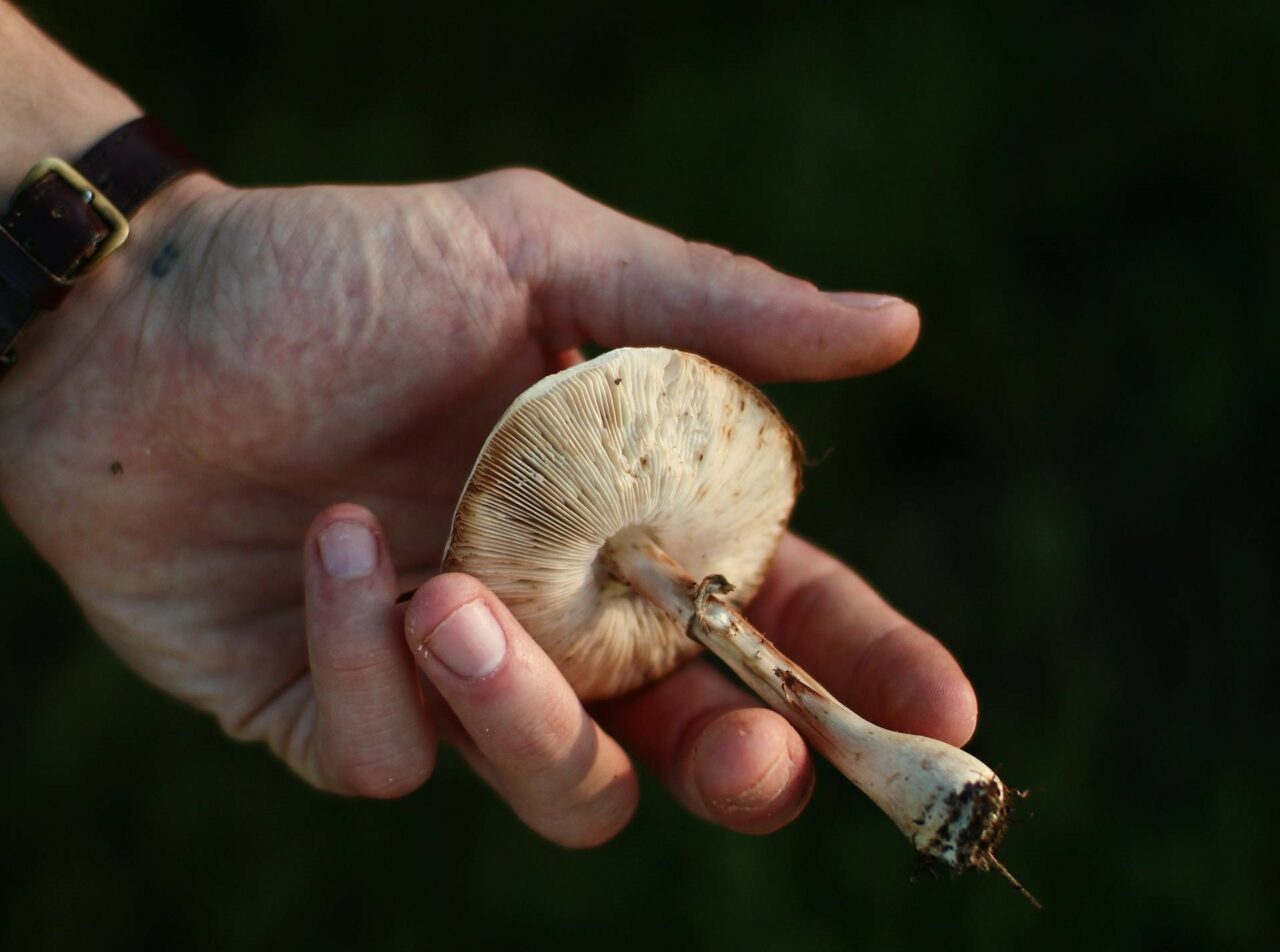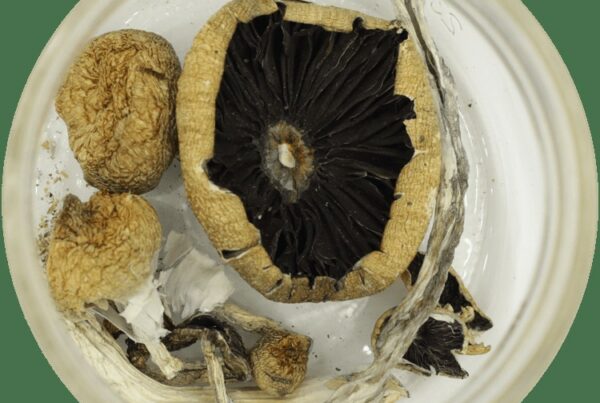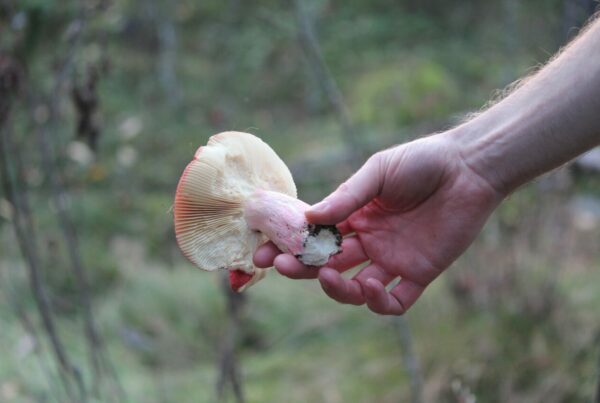Psilocybin mushrooms, likened to LSD due to their role as a serotonin 5-HT2A receptor agonist, are a classic psychedelic. Current research is exploring the potential of psilocybin-assisted therapy for various mental health conditions, such as emotional distress from major depression, anxiety, cluster headaches, and migraines.
To understand how shrooms can aid in mitigating these conditions, it’s essential to delve into their metabolism within the body. This knowledge can help researchers and users understand how the active compound produces its psychological and therapeutic effects. This article offers a basic overview of psilocybin’s pharmacology and pharmacokinetics.
[toc]
Key Takeaways:
- Half of the ingested psychedelic fungi is absorbed and spread throughout the body.
- The fungi compound is dephosphorylated by the enzyme alkaline phosphatase, primarily in the liver.
- Approximately 3.4% of the compound is excreted in its original form within 24 hours, with most being eliminated as a stable metabolite.
What is Pharmacokinetics?
Pharmacokinetics (PK) involves studying how the body deals with substances, like drugs, once they are introduced into the system. It’s different yet linked to pharmacodynamics, which looks at how a compound interacts with the body. PK primarily focuses on four areas: absorption, distribution, metabolism, and excretion (ADME).
Understanding these processes allows healthcare providers to prescribe the most effective medications with the lowest possible risk. It also empowers them to customize treatments based on each patient’s specific physiology and lifestyle.
How do Pharmacokinetics Relate to Psilocybin?
Psilocybin and psilocin, the primary active compounds in certain magic mushroom species, have piqued significant interest among researchers and users. Pharmacokinetics studies how the body processes mushrooms containing psilocybin, aiding in understanding their potential impacts, whether therapeutic or recreational.
These compounds are known by several monikers, including “magic”, “psychedelic”, “medicinal”, or “sacred”. The fungi harboring these compounds are consumed, with The types of these mushrooms, their origin, size, the conditions under which they prosper and are processed, along with their age, can greatly influence their potency levels.
Although these mushrooms are naturally found in the wild, scientific processes have been devised to reproduce them in laboratories. Both the organic and synthetic versions have low toxicity, but minor side effects like nausea or vomiting might occur.
Notwithstanding these physical impacts, the compounds within the mushrooms have demonstrated potential therapeutic advantages owing to their safe profile and non-addictive properties. This has prompted researchers to explore their applicability in psychotherapy, particularly as a remedy for anxiety and depression.
The Four Phases of Pharmacokinetics
Psilocybin, the compound found in these mushrooms, is inactive in its original state and functions as a prodrug, converting into its active form, psilocin. Enzymes such as alkaline phosphatase facilitate this transformation, enabling psilocin to be absorbed and distributed throughout the body, affecting various tissues. However, after oral intake, psilocybin cannot be detected in the circulatory system, feces, or urine.
Absorption
Absorption refers to the process by which the compound enters the bloodstream from the point of administration. It affects the speed and effectiveness at which the compound achieves its target, such as the plasma. Oral ingestion is the most common method of administration. Inhalation has been tried, but it is not as efficient as oral intake.
The absorption process also entails the compound’s liberation from the dosage form during oral intake. Factors such as delays in the throat or esophagus can influence this, potentially slowing the effects or causing discomfort. Once the compound reaches the stomach, the acid-rich environment may start to decompose it before it enters the bloodstream.
Studies on animals suggest that only around 50% of orally ingested psychedelics are absorbed and disseminated in the body.
Factors That Influence the Absorption Process
Several variables can affect the absorption process, leading to variations in the onset, intensity, and duration of effects:
- Stomach Contents: Consuming on a full stomach can slow down the process, thus delaying the onset of effects. Absorption is quicker on an empty stomach.
- Body Fat: Molecules can accumulate in fat tissues, potentially prolonging their effects.
- Age: Metabolism rates and body composition can change with age.
- Zero-Order Kinetics: Substance is expelled at a uniform rate, regardless of its concentration.
- First-Order Kinetics: The elimination rate is directly proportional to the drug’s concentration.
Dispersion describes how psilocin spreads throughout the body once it enters the bloodstream. As a lipophilic substance, psilocin is capable of traversing the blood-brain barrier to access the central nervous system.
Various factors, including the product’s size, polarity, and protein-binding capacity, as well as the individual’s physiological aspects – such as hydration status and body composition – significantly influence this process.
The goal is to achieve an effective concentration at the intended location. For the product to work, it must not only reach the target area (as determined by the volume of distribution), but also remain unbound to proteins, allowing it to actively interact with its receptor.
What Affects the Dispersion Process?
Several factors can impact the distribution process:
Typically, effects begin to manifest between 20-40 minutes after ingestion, peaking around 80-100 minutes. The effects of magic mushrooms generally last between 4-6 hours.
How Does Dispersion to the Brain Happen?
Early experimental research on two species indicated a binding affinity sequence of 5HT2A > 5HT1A > 5HT2B [23]. It also interacts with dopamine D1, 5HT1E, 5HT5A, 5HT7, 5HT6, D3, 5HT2C, and 5HT1B receptors.
It acts as a partial agonist at the 5HT2A receptor, with roughly 40% efficacy. Its psychedelic effects are largely due to its partial agonist activity at 5HT1A autoreceptors.
The mood-boosting and psychotomimetic experiences may result from the observed link between increased dopamine levels and feelings of depersonalization and elation. Hallucinogens work by changing neurochemistry and receptor activity. It enhances 5HT2A agonist activity by elevating BDNF synthesis in the hippocampus, which promotes neurogenesis and reduces fear-related behaviors.
Elimination
Elimination represents the process by which the
The human body primarily expels substances through the kidneys, but also through the lungs, skin, or gastrointestinal tract. When it comes to kidneys, they filter out a naturally occurring psychedelic drug in the glomerulus or secret it in the tubules. The process gets more complicated due to some reabsorption.
The primary compound has a half-life around 160 minutes, while psilocin’s half-life spans about 50 minutes. Animal testing indicates that urine primarily excretes this substance, making up roughly 65% within 8 hours. After consumption, the substance can be detected in smaller amounts in bile and feces.
In humans, approximately 3.4% of the substance is discharged in its original form within 24 hours. The majority is eliminated as psilocin-O-glucuronide, a more stable metabolite. This stability allows the compound to be traced in urine samples over a longer duration.
Substance removal occurs through two primary methods:
Most psychedelic drugs follow the first-order kinetics method, reaching consistent concentrations after four to five half-lives. Full removal also occurs after four to five half-lives.
Discover Our Range of Hallucinogenic Mushrooms
The metabolic process differs among various species of fungi. To avoid the accidental consumption of toxic mushrooms, consider purchasing from reliable online suppliers like Shrooms Online Canada. Some mushrooms, such as Agaric mushrooms, can induce strong and unpleasant effects. Therefore, sourcing magic mushrooms from trusted dispensaries is safer than buying from street vendors or foraging in the wild.
| Feature | Enigma | Full Moon Party | Gold Member | |
| Strain Type | Psilocybe Cubensis OMNI | Psilocybe cubensis (Thai Koh Samui) | Psilocybe cubensis | |
| Potency | Exceptionally high; 3.8% tryptamine content | Moderate to high potency | High potency | |
| Visual Characteristics | Resembles a blob or | Resembles a brain or cauliflower | Typical cubensis form; moderately sized | Thick white stems with golden caramel-colored caps; visible blue bruising |
| Effects | Considered the most powerful; creates intense effects | Produces a strong mental high; visuals are delayed but noticeable | Produces intense visuals and feelings of euphoria |
Educate Yourself on Psilocybin Mushroom Usage Online
It’s crucial for medical professionals, researchers, and users to understand the pharmacokinetics of shrooms. This knowledge will enable you to make knowledgeable decisions about dosage and timing, thus reducing potential risks.
Discover your perfect psychedelic experience at Shrooms Online Canada. Whether you prefer a serene journey or a deeper exploration, our vast product selection is tailored to meet your unique needs. Enjoy top-quality, safe, and rigorously-tested shrooms, eliminating worries about uncertain sources or poisonous mushrooms.
Experience the best magic mushrooms Canada has to provide, and take your psychedelic journey to new heights.
Frequently Asked Questions
Are there any known interactions between shrooms and other medications?
Our products might interact with certain medications, particularly those that affect serotonin levels, like SSRIs (Selective Serotonin Reuptake Inhibitors). SSRIs and SNRIs (Serotonin and Norepinephrine Reuptake Inhibitors) generally reduce the effects, unlike non-serotonergic antidepressants. This reduced effect can last up to three months after discontinuing the antidepressant.
Do all psychedelics follow the same pathway as psilocybin?
No, each psychedelic substance has a unique structure that requires different metabolic processes to become active. They also bind to various receptors within the body. The method of administration also affects how each psychedelic is absorbed. Although the basic principles of absorption, metabolism, and distribution remain the same, the specific pathways and effects differ for each substance.
Can the form of the shroom affect its pharmacokinetics?
Yes, the form (such as fresh, powdered, or dried mushrooms) can influence the absorption rate. For example, powdered forms may be absorbed faster than whole dried ones due to quicker dissolution.
Suggested Further Reading:





